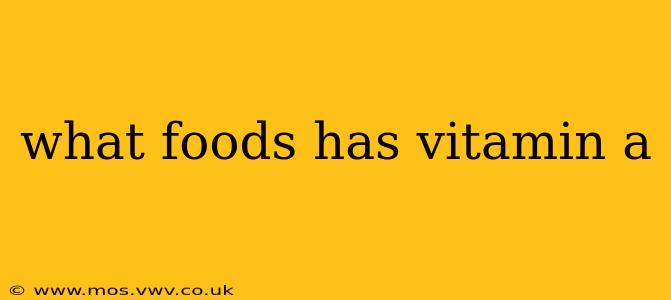Vitamin A is a fat-soluble nutrient crucial for maintaining good vision, supporting a healthy immune system, and promoting cell growth. It exists in two primary forms: preformed Vitamin A (retinol) found in animal products, and provitamin A carotenoids (like beta-carotene) found in plants. Both are essential for optimal health, but your body converts carotenoids into Vitamin A as needed. This guide explores various food sources rich in Vitamin A, addressing common questions along the way.
What are the best food sources of Vitamin A?
The best food sources of Vitamin A vary depending on whether you're looking for preformed Vitamin A or provitamin A carotenoids. Let's break it down:
Excellent Sources of Preformed Vitamin A (Retinol):
- Organ Meats: Liver (beef, chicken, pork) is exceptionally high in Vitamin A. Just a small serving packs a significant punch.
- Fatty Fish: Salmon, tuna, and cod liver oil are excellent choices, offering both Vitamin A and healthy omega-3 fatty acids.
- Dairy Products: Whole milk, cheese (especially cheddar and Swiss), and yogurt provide decent amounts of Vitamin A, particularly full-fat varieties.
- Eggs: Both the yolk and white contain Vitamin A, making eggs a convenient and nutritious source.
Excellent Sources of Provitamin A Carotenoids (Beta-Carotene & Others):
- Sweet Potatoes: These vibrant orange tubers are superstars when it comes to beta-carotene.
- Carrots: Another classic, carrots offer a good dose of beta-carotene, contributing to their characteristic orange color.
- Dark Leafy Greens: Spinach, kale, collard greens, and turnip greens are packed with various carotenoids, including beta-carotene, lutein, and zeaxanthin.
- Pumpkin: Both pumpkin puree and pumpkin seeds are good sources of beta-carotene.
- Mangoes: These tropical fruits are not only delicious but also provide a good amount of beta-carotene.
- Apricots: Both fresh and dried apricots offer a decent amount of beta-carotene.
What foods are high in beta-carotene?
As mentioned above, sweet potatoes, carrots, pumpkin, mangoes, and apricots are excellent sources of beta-carotene. Dark leafy greens also contain significant amounts. The vibrant orange or deep yellow color of many of these foods is a good indicator of their high beta-carotene content.
Is there Vitamin A in fruits?
Yes, several fruits contain provitamin A carotenoids. Mangoes, apricots, and cantaloupe are good examples. However, the concentration of Vitamin A in fruits is generally lower than in many vegetables and animal products.
Which vegetables are rich in Vitamin A?
Many vegetables are rich in Vitamin A, particularly those with vibrant orange, yellow, or dark green colors. Examples include sweet potatoes, carrots, spinach, kale, collard greens, and pumpkin.
How much Vitamin A do I need daily?
The recommended daily allowance of Vitamin A varies depending on age, sex, and overall health. It's best to consult a healthcare professional or a registered dietitian to determine your individual needs. They can help you create a balanced diet that meets your Vitamin A requirements and overall nutritional goals. Excessive Vitamin A can be toxic, so moderation is key.
Can you get too much Vitamin A?
Yes, it's possible to consume excessive amounts of Vitamin A, particularly preformed Vitamin A (retinol). This can lead to hypervitaminosis A, which can cause symptoms like nausea, headaches, blurred vision, and liver damage. It's crucial to maintain a balanced diet and not overconsume foods exceptionally rich in Vitamin A, especially liver.
This guide provides a comprehensive overview of Vitamin A-rich foods. Remember to consult with a healthcare professional for personalized dietary advice to ensure you're meeting your individual nutritional needs safely and effectively.
